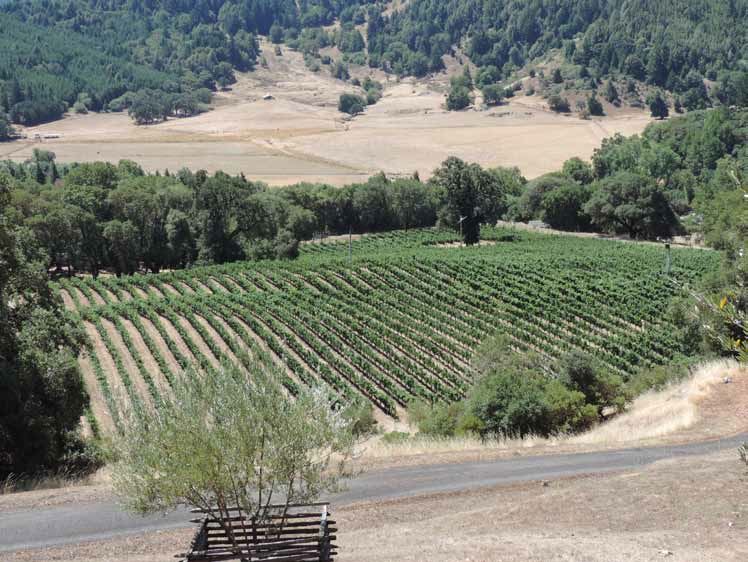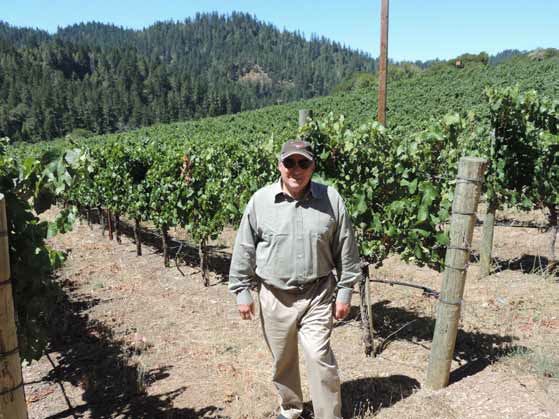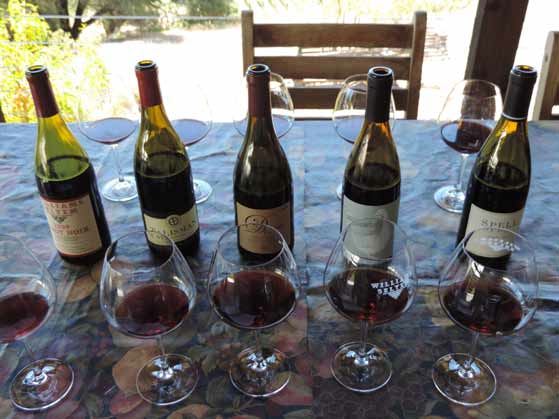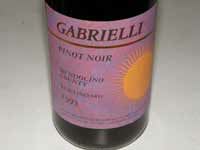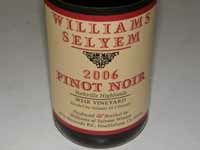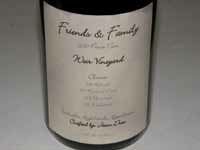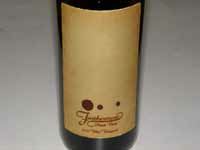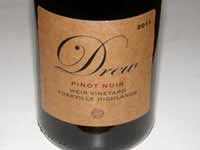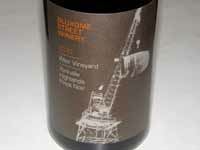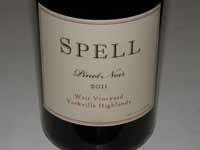Weir Vineyard: Getting to Know Winegrower Bill Weir and the Pinot Noirs from His Very Special Vineyard
This article is the first in a series of in-depth profiles of distinguished Pinot Noir vineyards in California and
Oregon. The vineyards are chosen for their record of producing consistently high quality Pinot Noir over
multiple vintages, in some cases by several winemakers. At this time, we lack a classification of vineyards in
North America and there is no established nomenclature to signify levels of quality such as found in Burgundy.
Bill Weir spent his formative years in Chicago living with his mother after his father died when Bill was very
young. His mother moved the family to Mill Valley in Northern California when Bill was 16. After a stint in the
marines, he attended junior colleges looking for a career and eventually went to University of California at
Berkeley to study architecture and mechanical engineering, both fields that would come in handy in the
establishment of his vineyard in years to come. He eventually changed his major to business administration
and was encouraged to enter law school. After graduating from Hastings Law School, he successfully
practiced law in San Francisco for 40 years.
During his years of law practice, Bill made wine in his garage with friends, an activity that led to some marital
discord since he had cases of wine scattered all over the house. His wife, Suki, told him, “Your wine is mediocre
at best, so stop it.” Bill, who was looking for a long term exit strategy from the practice of law, offered her a
compromise. In 1987, he had acquired a 160-acre property in the Yorkville Highlands appellation near
Anderson Valley, formerly part of a 5,000-acre sheep ranch. He asked Suki if he could grow grapes there if he
agreed to stop making wine. She was receptive, based on two conditions: He had to attend formal viticulture
school and he had to look at winegrowing as a business.
Beginning in 1989, Bill attended night and weekend classes at Santa Rosa Junior College under the tutelage of
Rich Thomas. He also traveled to Burgundy where he sought out advice and insight. In 1991, he had a
consultant look at the property and examine the soils. The consultant told him that Syrah, Zinfandel, Pinot Noir
and Chardonnay were feasible options. Because of his visit to Burgundy and his personal preference, he
decided to plant Pinot Noir. This was a daring decision, since there was no significant precedent for growing
Pinot Noir in the Yorkville Highlands.
Yorkville Highlands AVA
The Yorkville Highlands AVA, approved in 1998, is located in the southwestern corner of Mendocino County, between Sonoma
County!s Alexander Valley to the South and Mendocino County!s Anderson Valley to the North. The region is 25 miles long,
roughly in the shape of rectangle and bisected by Highway 128 which runs the length of the AVA. The region!s terrain is hilly and
forested, with elevations ranging from 1,078 to 2,442 feet above sea level.
The distinguishing features of the Yorkville Highlands AVA are rocky soils with a high gravel content and the climate, which is
cooler than Alexander Valley but warmer than Anderson Valley, and significantly cooler at night than the surrounding areas.
Temperatures range from 50º to 77º with an average of 63.5º during the growing season. Total growing degree-days to ripen
grapes is 1603.3, making it a Region I in the UCD heat summation classification (source: www.everyvine.com).
Of the 44,104 acres, only 0.1% is planted to grapevines. Bordeaux and Rhone varieties make up the vast majority of plantings,
and Pinot Noir is usually designated under the tiny “other” category, amounting to only 49 acres compared to the neighboring
Anderson Valley!s 1,128 acres (2008 figures from Glenn McGourty).
The Yorkville Highlands Growers and Vintners Association, www.yorkvillehighlands.org, lists ten wineries in the appellation. Of
these wineries, only Judson Hale Winery grows Pinot Noir. Baldassari is a newer, family owned winery in the AVA producing
Pinot Noir. Wattle Creek Winery, located in Cloverdale, also grows and produces Pinot Noir from the Yorkville Highlands.
A map of the region follows. Weir Vineyard can be located on this map by following Highway 128 from the AVA!s northernmost
border south about 5 miles. Two closely adjacent vineyards in green are noted on the eastern side of Highway 128. These are
the two halves of the Weir Vineyard.
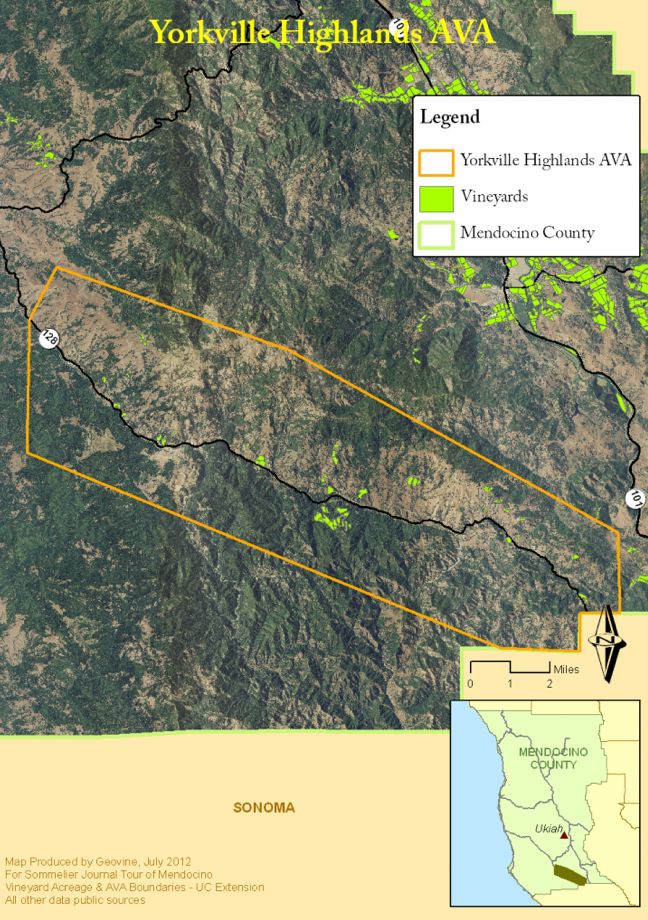
The Weir Vineyard property is located about 7 miles south of Boonville in the Anderson Valley near the
headwaters of the Navarro River at 900 to 1000 feet elevation (Anderson Valley in comparison is about 400
feet elevation in Boonville). There is a melange of soils which fall into the Yorkville Series that are mountainous,
deep, well drained, and composed of schist, brittle sandstone, and other sedimentary and metamorphic rocks
including quartz. Some percentage of loamy clay keeps the soil united.
The climate is characterized by dramatic diurnal shifts in temperature of 40º to 50º. Bill considers the diurnal
bounce to be the key to the success of his vineyard, since he thinks the nighttime cooling intensifies polyphenol
compounds (flavors), preserves acidity, and produces smaller berries during the growing season. (The value of
high diurnal temperature variation is a controversial subject among viticulturists).
Respected viticulturist Steve Williams was recruited to determine the vineyard!s initial 7.5-acre layout and plant
the vineyard. Bill says Steve “gulped” when Bill told him he wanted to plant PInot Noir. In 1990, tree removal
began, vines were bench grafted at a nursery in Fresno in 1991, and the vines went in the dirt in June 1992.
Wädenswil clone and a rumored DRC selection from Mount Eden were initially planted on 5C rootstock using a
VSP trellis system with 8! x 5! spacing. Bill declined to use AXR rootstock because it was not phylloxera
resistant. 5C is adaptable to a wide range of soil types, but is not suitable for very dry soils. Bill says the water
status of the vines must be carefully monitored, because if the vines become thirsty, they can shut down and
not revitalize. Fortunately for Bill, the property has subterranean pockets of water which are sufficient for the
5C rootstock when supplemented by drip irrigation. Bill prefers to limit irrigation, however, believing that pre-veraison
water deprivation leads to enhanced grape flavors.
Initially, Bill came up to the vineyard on weekends from San Francisco and stayed in a mobile home on the
property. He dug a well to supply the vineyard, but within three weeks all of his water was gone. He was forced
to pipe in water from a neighboring sheep rancher and the following winter he dug additional wells (he now has
five working wells), and established a spring with 10,000 gallon tanks for water storage. His sheep rancher
friend, Guido, looked after the property and at one time had 100 head of sheep grazing on Bill's land. The
sheep provided a pastoral presence and kept the weeds and grasses down, but when Guido passed away two
years ago, Bill let the sheep go.
Bill recounts his winegrowing experience, saying, "To grow fine, distinctive Pinot Noir grapes, you need an unending body of knowledge. You need chemistry and biology, even engineering and mechanics as well as the basics of meteorology and just plain farming. The extent of what you don't know limits your results."
The initial planting is referred to as the East vineyard ( a 7.5-acre West vineyard was planted later). The south-facing
East vineyard is on a hillside and somewhat protected from the wind but cold air rolls down to the bottom
area of the vineyard, and Bill found it necessary to protect the vines from frost. In 1995 he installed a large fan,
one of the first in the region. The East vineyard is pictured below (the giant fan is visible in the distance).
Bill and his family lived in the property!s mobile trailer on the weekends for eight years before his wife and kids
put their feet down. They insisted on a shower and inside bathroom, so Bill built a small house in 1997 to
maintain family harmony. He has since designed and added a second house, a subterranean wine cellar and a
deck for entertaining.
The first grapes that were harvested from the East vineyard in 1993 were sent to Gabrielli Winery in Redwood
Valley where they were extremely well received. Since the quantity was small, the grapes were mixed with
other Pinot Noir grapes. The resulting wine won a Gold Medal at the Mendocino County Fair. The following
two vintages, 1994 and 1995 were bottled as a Weir Vineyard-designate by Gabrielli Winery.
Now the history gets entwined and highly interesting. In the mid-1990s, Bill had become fond of Williams
Selyem Pinot Noir, signed on the mailing list to receive the wines, and made an appointment to see Burt
Williams. He took a bottle of 1994 Gabrielli Weir Vineyard Pinot Noir, hoping that Burt might purchase Weir
Vineyard grapes. Burt, never one to waste words, tasted the wine and said, “Keep me apprised.” The following
year Bill returned with the 1995 Gabrielli Weir Vineyard Pinot Noir and after tasting the wine, Burt said,
“Interesting.”
Meanwhile, Bill sold some grapes to Keith Rutz at Rutz Winery in the Russian River Valley. Rutz!s winemaker
was Dan Moore, also the winemaker at Lynmar at the time. When Moore left, Keith hired Burt!s son, Fred.
Fred Williams blended the 1995 vintage at Rutz, made the 1996 vintage and half of the 1997 vintage before
departing and starting his own label, Seven Lions. Fred loved the fruit from Weir Vineyard.
When Fred left Rutz, Burt came to Bill and said, “OK, I!m ready for your fruit.” A handshake deal was cut at the
end of 1997 and the first Williams Selyem Weir Vineyard Pinot Noir debuted in the 1998 vintage. In the spring
of 1998, Burt came to Bill and told him the winery was for sale. Bill wanted the grapes to follow Burt, and Burt
said he would be consulting for another couple years, but with the sale, a written contract was required. Burt
left Williams Selyem after a year, but the grapes have been sourced by Williams Selyem ever since.
Bob really beams when he talks about Burt Williams and speaks endlessly about Burt!s achievements. He
considers him an icon of California Pinot Noir, setting the gold standard for the varietal in 1983 to 1985.
The second 7.5-acre West vineyard was planted in 2000. 50% of the vineyard is the same DRC selection
planted in the East vineyard, 25% is Pommard 4, and 25% is a Rochioli Riverblock selection. One small patch
of the West vineyard is planted to Nebbiolo. This is Bill!s “pet project” that he planted five years ago and has
been struggling with it. He says he is excited about it, and 2013, the fifth leaf, will be a telling year. Photo
below shows Bill in the West vineyard.
Bill has supplied grapes to a number of noteworthy Pinot Noir producers including Williams Selyem (about 50%
of the vineyard!s production), Baxter, Bink Wines, Bluxome Street Winery, Drew Family Cellars, Furthermore,
SPELL Wines, Talisman, and Toulouse. He has bottled his own Pinot Noir as well, both as a “Family and
Friends” label and as “Lizzy!s Cuvée,” which is donated to raise money to fight cancer (in memory of Bill!s
sister-in-law who died from cancer).
Bill, himself is a remarkable cancer survivor. In 2006, while being evaluated for kidney stones, he was found to
have pancreatic cancer. He was diagnosed with the most aggressive adenocarcinoma type of pancreatic
cancer which has a survival rate of less than 5%. Bill was told he had 6 months to live, but was offered a new
type of chemotherapy developed by Genentech that required infusions of a drug every two weeks for 48
weeks. He underwent the treatment and despite being in his words, “cooked,” he survived the side effects. He
soon felt better, his tumor began to shrink, and within three years had disappeared completely. Bill jokingly
remarked, “God must not have been done with him, giving him more time to come up with some great
Nebbiolo!”
Bill retired in 2007 amid the cancer scare and now spends nearly half his time at Weir Vineyard. When I
visited, he was cleaning out dead prey from the vineyard!s owl houses and looking forward to some family
members visiting that evening. As we toured the large property and walked the vineyard together, it was clear
that Bill was proud of his accomplishments. I felt honored to tell his remarkable story.
On his deck overlooking the vineyard, we tasted five Weir Vineyard Pinot Noirs, all of which were special. My
tasting notes of these wines follow along with reviews of several more Weir Vineyard Pinot Noirs that I tasted
after my visit to Weir Vineyard, some of which Bill kindly supplied. Like so many wine lovers, he relishes the
chance to share.
Remington Norman (Grand Cru, 2010) has said, “In addition to its physical and situational components, terroir
has a human dimension....Sit over a glass of great Burgundy and discussion rapidly comes around to how far
the hand of man, as much as that of plant, site and climate, is reflected in the wine. “Great terroir only
represents potential, for man is necessary to bring it to complete fruition.” Weir Vineyard is a perfect example
of this. Bill has had considerable influence on his site, soil, and how his vines perform and represents an
integral part of the Weir Vineyard terroir
Weir Vineyard Pinot Noir displays a number of enticing features including remarkable fruit purity and tension,
mid palate richness, bright and mineral-driven acidity, and enough structural bones for age ability. A floral note
tends to show up on the nose, and many wines have a savory component. All wines tend to improve over time
in the glass with aeration. The most typical and distinguishing feature of every bottle that I have tasted
can be summarized by a six-letter word: FINISH. The Weir Vineyard Pinot Noirs offer a finish of heightened
intensity and uncommonly generous length which is the hallmark of great wine. It is often said that the feature
that most distinguishes a Grand Cru Burgundy is the length of finish.
Bill has said, "The deep personal involvement with growing these grapes has tremendously enriched our enjoyment of our lives. We think this will come through in the wine." This is definitely true.
1995 Gabrielli Weir Vineyard Mendocino County Pinot Noir
13.8% alc..
·
Dark reddish-purple color with no bricking in the glass. The nose offers some
old wine funk along with pleasing notes of black cherry, black olive, worn leather
and oak. Still alive on the palate with appealing mid weight flavors of black
cherry and blackberry fruit with an earthy, gamey undertone. The tannins are
modest, the acidity is uplifting and the finish is strikingly long and crisp. This
wine is holding its own after nearly twenty years, and must have been
exceptional in its prime. Drink.
Score: NR
1999 Williams Selyem Weir Vineyard Yorkville Highlands Pinot Noir
13.7% alc.
·
Moderately dark reddishpurple
color in the glass. The nose is heavily oak-driven but likable, featuring scents of toasty oak, baking
spice, vanilla, gingerbread and hazelnut. The black cherry fruit is still holding its own with good richness on the
mid palate and finish. An underpinning of earthiness and gaminess adds interest. Silky in the mouth with firm
tannins and a good cut of acidity. Drink.
Score: 88
2002 Williams Selyem Weir Vineyard Yorkville Highlands Pinot Noir
14.1% alc..
·
Moderately dark reddishpurple
color in the glass. Very fresh aromas of dark cherries and berries with a hint of cardamom spice. The
fruit really sings on the palate and finish, offering vibrant expressions of blackberries, black raspberries, black
currants and sassafras. The prodigious fruit is well-balanced by firm tannins and lively acidity. Finishes on a
high night with fruit-driven power. Drink.
Score: 93

2006 Williams Selyem Weir Vineyard Yorkville Highlands Pinot Noir
14.4% alc., $56. Aged 15 months in 69% new and 31% 1-year-old
French oak barrels.
·
Medium reddish-purple color in the glass. Lovely
nose offering dreamy aromas of fresh Bing cherries, rose petals, baking
spice including nutmeg and potpourri. Delicious concentrated core of
crunchy Bing cherry and black raspberry fruit with a cola accent finishing
with a long, long explosion of citrus-infused cherry goodness. Lighter in this
vintage, and noticeably crisp with admirable tension and minerality. A seamless
wine of impressive sophistication. Drink or hold.
Score: 95
2007 Baxter Weir Vineyard Yorkville Highlands Pinot Noir
14.8% alc., 75 cases.
·
Medium deep red color in
the glass. Aromas of red cherries, spice and vanilla. Modest weight flavors of red cherries and berries and
pomegranate with a hint of earthiness and baking spice. Bright acidity adds juiciness and the supple tannins
add softness. A little alcohol shows up on the finish. Drink or hold.
Score: 87
2008 Williams Selyem Weir Vineyard Yorkville Highlands Pinot Noir
14.2% alc., $56. Aged 17 months in
65% new and 35% 1-year-old French oak barrels.
·
Medium reddish-purple hue in the glass. Aromas of black
cherries, spice, earth, dark chocolate and sweet smoke. Middleweight flavors of wild berries and black cherries
with a hint of tarry smoke. Balanced tannins with bright supporting acidity and a remarkable long and rich
finish. The wine displays subtle signs of smoke taint and reportedly it underwent a filtering procedure in an
attempt to remove the smoke taint which was somewhat successful. Drink.
Score: 87
2009 Bink Weir Vineyard Yorkville Highlands Pinot Noir
14.2% alc., $38.
·
Moderately light ruby red color in
the glass. Demure aromas of cherries, spice, briar and marzipan. Lighter style, featuring flavors of dark
strawberry and cherry with an earthy, cola-driven underpinning. The tannins are fine grain and modest, the
acidity is bright and the wine is quite enjoyable although it does not offer the mid palate impact and finish of
some other Weir Vineyard wines tasted. Drink or hold.
Score: 89

2009 Williams Selyem Weir Vineyard Yorkville Highlands Pinot Noir
13.9% alc., $56. Aged 15
months in 65% new and 35% 1-year-old French oak barrels.
·
Moderate reddish-purple color in the
glass. So aromatic you want to bottle the nose. Scents of dark cherries, spice and loamy earth with a
slight savory tone. Very concentrated and flavorful, featuring dark berries, black cherries, cola and
spice. Intense, eyebrow-raising, long, long finish. Fabulous. Drink or hold.
Score: 97
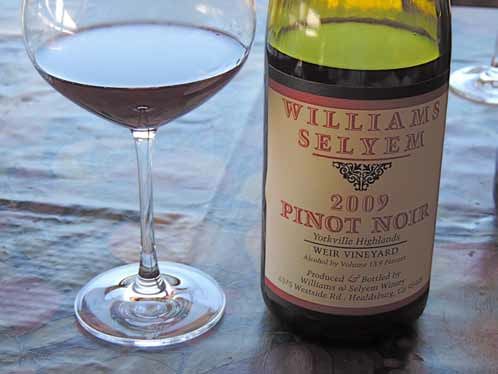
2009 Drew Weir Vineyard Yorkville Highlands Pinot Noir
13.9% alc., 180 cases, $42. Average Brix 24.5º at
harvest. Yields 2.3 tons per acre. 15% whole cluster fermentation. Aged in 30% new French oak barrels.
Unfined and unfiltered.
·
Moderately dark reddish-purple color in the glass. Aromas of tea leaf, brandy-infused
cherries, rose petals and marzipan. Rich core of deep red cherry and black raspberry fruits with a hint of
cassis, spice and nuttiness running through. The tannins are firm, the acidity is bright, and the finish is
remarkable intense and lengthy. Hold.
Score: 90
2009 Talisman Weir Vineyard Yorkville Highlands Pinot Noir
14.5% alc., 237 cases. One of the last to pick
in this vintage.
·
Moderately dark reddish-purple color in the glass. This is an outstanding wine that offers a
more savory take on Weir fruit. The middleweight flavors of darker cherries and berries are appealing, the
acidity is uplifting, and the herb-driven finish is delightful. Drink or hold.
Score: 92
2010 Bluxome Street Weir Vineyard Yorkville Highlands Pinot Noir
14.3% alc., 250 cases, $45.
·
Medium
reddish-purple hue in the glass. Alluring aromas of black cherry, toasty new oak, brier and tobacco. Delicious
essence of black cherry pie glaze that coats the mouth and holds on indefinitely for a peacock finish of
uncommon length. Still sporting sinewy tannins that need time to soften and integrate. A big gulp of Pinot.
Hold.
Score: 91
2010 Drew Weir Vineyard Yorkville Highlands Pinot Noir
14.5% alc., 98 cases, $42. 30% stem inclusion,
native fermentation, aged 11 months in 25% new French oak. Unfined and unfiltered.
·
Moderately dark
reddish-purple color in the glass. The shy nose unfolds slowly in the glass, revealing aromas of black cherries,
black raspberry, briar and violets. The concentrated core of savory dark red and black fruits fill the mouth,
caressed by well-matched tannins, underlain with bright acidity, and finishing with good cherry richness and
length. Drink or hold.
Score: 89
2010 Friends & Family Weir Vineyard Yorkville Highlands Pinot Noir
14.8%
alc., 75 cases. Contains all clones from the vineyard: 38% Rochioli, 25% “DRC,”
20% Pommard, and 12% 2A. Winemaker Jason Drew.
·
Moderate reddishpurple
color in the glass. The nose is crazy good with deep, penetrating aromas
of wild berries and spice. Soft and smooth on the palate with layered flavors of
darker berries and plum sauce with a slight hint of oak in the background. Rich
and sappy and definitely on the ripe side, but a delight to drink. Good tension,
beautifully crafted, and sporting the signature Weir finish. Lucky family and
friends. Drink or hold.
Score: 93
2010 Furthermore Weir Vineyard Yorkville Highlands Pinot Noir
14.4% alc.,
76 cases, $50 (375 ml, $25). Average harvest Brix 27.6º. Native fermentation.
Aged 12 months in 33% new French oak barrels.
·
Moderately dark reddishpurple
color in the glass. Very nicely appointed wine with lovely aromas of dark
red cherries and berries, rose petals and the inside of a woman!s leather glove.
Discreetly concentrated core of dark red fruits with a savory, herbal undertone.
The oak is well-integrated, the tannins are ripe and balanced, and there is a
satisfying kick of acidity on the finish which is of extraordinary length, lasting
more than 30 seconds. Drink or hold.
Score: 92
2010 Toulouse Weir Vineyard Yorkville Highlands Pinot Noir
14.4% alc..
·
Moderately light garnet color in
the glass. The leanest interpretation of this vineyard that I have tasted, but a solid wine. Aromas of cherries,
violets and spice. Dark red fruit flavors with an earthy, savory bent are featured on the modest palate. Lively
and fresh, with some finishing presence. Drink.
Score: 87
2011 Drew Weir Vineyard Yorkville Highlands Pinot Noir
13.3% alc., 99
cases, $42. Average Brix 23º at harvest. Yields 2.1 tons per acre. 50% whole
cluster fermentation. 100% native fermentation. Aged 11 months in 25% new,
25% 1-year-old and 50% 2-year-old French oak barrels. Unfined and unfiltered.
·
Moderately light reddish-purple color in the glass. Very nicely appointed nose
offering scents of cherries, pear and exotic spices. Lighter in this vintage, with
an array of layered red fruits that fill the mouth with pleasure. Savory dried
herbs and spice add interest. The tannins are well-behaved, the acidity brings
focus and brightness to the wine, and the typical Weir finish leaves a lasting
impression. This wine is showing definite whole cluster influence now with a slight green tone, and should age
extremely well. Drink or hold.
Score: 91

2011 Bluxome Street Weir Vineyard Yorkville Highlands Pinot Noir
14.2% alc., 175 cases, $45.
·
Medium garnet color in the glass. The nose
is really enticing, offering scents of briar, red cherry, and violets, but the
flavors are remarkable. Red and black cherries, red plums. brewed tea
and spice coat the mouth and finish with a peacock tail of glorious note.
The finish lasts at least a minute, returning several times for an encore.
In addition, the wine is seductively soft and smooth on the palate with a good cut
of underlying mineral-driven acidity. The whole package. Drink or hold.
Score: 96

2011 Spell Weir Vineyard Yorkville Highlands Pinot Noir
13.4%
alc.., 90 cases, $50.
·
Moderate reddish-purple color in the glass.
Incredibly fragrant, alive with aromas of black cherries, dark berries,
dark red rose petals, mocha, and baking spice. Intense, delicious mid
palate flavors of cherry pie glaze, black raspberry, purple plum, spice,
and dark chocolate with a touch of oak in the background. Plenty of
acid-driven vigor and balanced tannins. Soft in the mouth and easy to drink. The
finish is outrageously long, juicy and intense.
Score: 95
2010 Weir Vineyard Yorkville Highlands Nebbiolo. Vinfied by Ryan McAlister. Unlabeled. Medium
reddish-purple color in the glass. Shy aromas of brandy-soaked cherries, briar and rose petals. Tasty array of
mid weight red cherry fruit with some Pinot character and a long finish offering cherry skin and dried herb
flavors. The fruit is elevated by fresh acidity but is somewhat buried in muscular tannins. Needs a good steak
or ossobuco to tame the tannins. NR.




